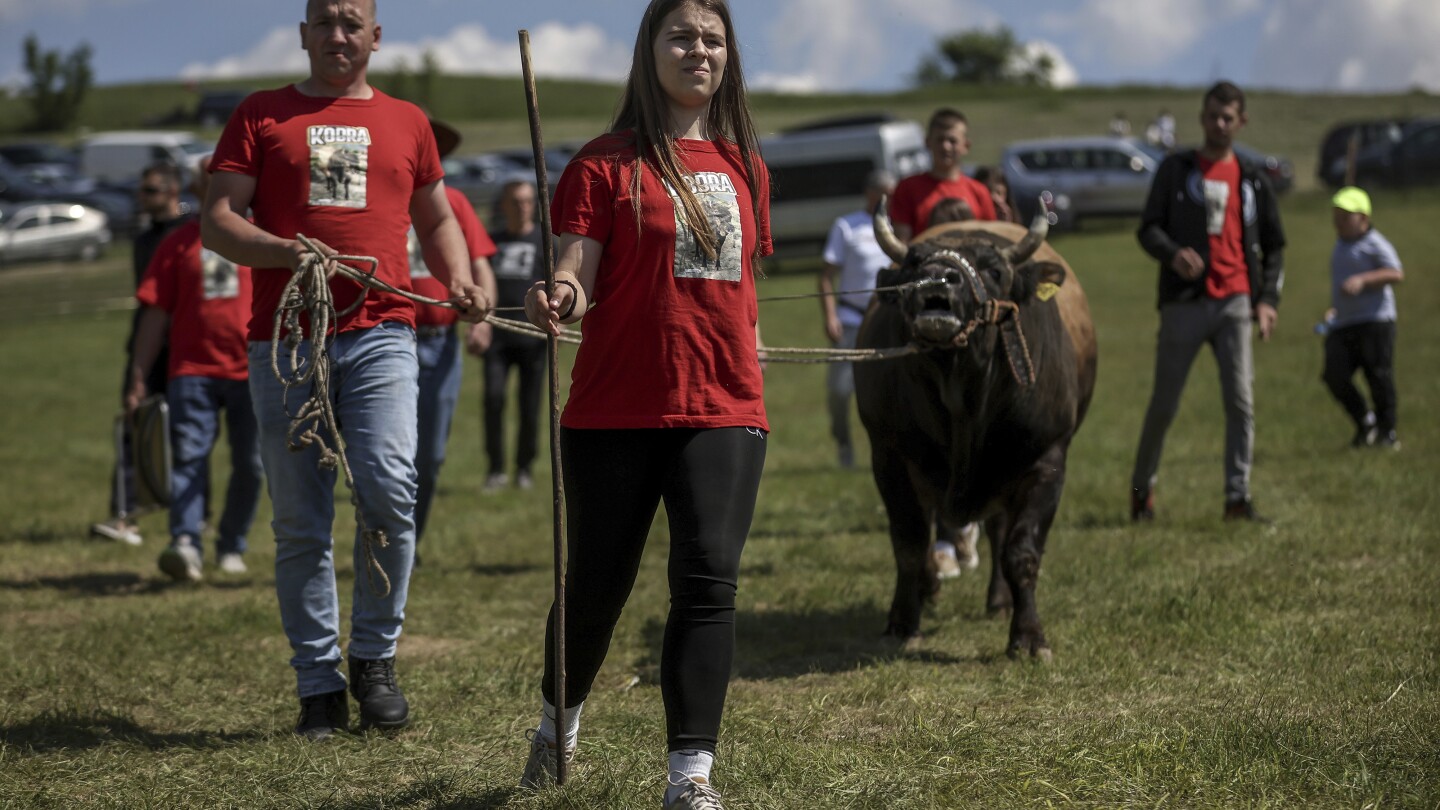Lifestyle
US egg prices fall for the first time in months but remain near record highs

U.S. retail egg prices fell in April from the record-high prices they hit earlier this year, according to government data released Tuesday.
The average price for a dozen Grade A eggs declined to $5.12 last month after reaching a record $6.23 in March, according to the Consumer Price Index. It was the first month-to-month drop in egg prices since October 2024.
Overall, the average price of eggs of all sizes fell 12.7%, the steepest monthly decline since March 1984.
While wholesale egg prices have been coming down for a while, it was unclear how much store prices would decrease in April because consumer demand is usually high around Easter and Passover.
Still, retail egg prices remain near historic highs as a persistent outbreak of bird flu wipes out flocks of egg-laying hens. The April average price for a dozen large eggs was 79% higher than the Bureau of Labor Statistics reported for the same month a year ago, when the price averaged $2.86 per dozen.
Bird flu has killed more than 169 million birds since early 2022. Any time a bird gets sick, the entire flock is killed to help keep bird flu from spreading. Once a flock is slaughtered, it can take as long as a year to clean a farm and raise new birds to egg-laying age.
That can have an effect on the egg supply because massive egg farms may have millions of birds. Outbreaks on two farms in Ohio and South Dakota last month affected more than 927,000 egg-laying hens.
Lowering egg prices has been a particular focus of President Donald Trump. In February, the U.S. Department of Agriculture said it would invest $1 billion to help farmers improve their biosecurity measures to fight bird flu.
The U.S. has also increased imports of eggs from South Korea, Turkey, Brazil and other countries. According to Wells Fargo Agri-Food Institute Sector Manager Kevin Bergquist, the volume of egg and egg product imports increased 77.5% during the first three months of the year compared to the same period a year ago.
The antitrust division of the U.S. Department of Justice is also investigating Cal-Maine Foods, the largest U.S. egg producer, which supplies around 20% of America’s eggs. Cal-Maine confirmed the investigation in early April..
Ridgeland, Mississippi-based Cal-Maine said its net income more than tripled to $508.5 million in its most recent quarter, which ended March 1.
Lifestyle
‘Doctor Who’ and Eurovision will unite for a night of music and intergalactic adventure

LONDON (AP) — “Doctor Who” and Eurovision unite for an evening of music and intergalactic adventure on Saturday — all thanks to Russell T Davies.
Before fans tune in for the annual song contest, they can enjoy Ncuti Gatwa’s Doctor and Varada Sethu’s Belinda Chandra attending the Interstellar Song Contest in an episode of the sci-fi series.
In real life, the Eurovision Song Contest is an annual musical competition and TV event that sees 37 countries compete for a crystal microphone trophy over a four-hour live broadcast. In the interstellar version, aliens from 40 different worlds vie to win, also by singing.
Davies says it took three years to pull it off the doubleheader because they had to work with the BBC to set the schedule and storylines in stone to ensure a perfect alignment.
Britain’s Sam Ryder took a “Space Man” to Eurovision before, in 2022. Now, Gatwa will read out the U.K.’s jury scores during the song contest’s grand final, held this year in Basel, Switzerland.
Talking to The Associated Press, Davies says that both Eurovision and “Doctor Who” share the DNA of old-fashioned Saturday night television, making the combination “irresistible.”
This conversation has been edited for clarity and brevity.
AP: Do you feel that Eurovision and “Doctor Who” naturally share a kind of fandom?
DAVIES: I almost think every episode of “Doctor Who” is a great big celebration, sort of noise and color and spectacle, and that sums up Eurovision as well. In pitching this to Disney+ as well it’s like, “Look we’re going out in 60 of your territories” and Eurovision itself has a viewing figure that some years is bigger than the Super Bowl. There’s not many shows that can say that on planet Earth.
AP: How much fun did you have with the lore of Eurovision?
DAVIES: It’s enormous fun. It could be said if you’ve never seen a single Eurovision Song Contest in your life, you can still come along and watch this. It’s the kind of thing we’d have made up for a “Doctor Who” story anyway.
One day I’ll do that “ABBA Voyage” story where the holograms come to life and start killing people. That’s the best idea ever. We’ve got to do that one then. Can you imagine? That would be just amazing. I think there might be some copyright problems with that but we’d overcome them.
The actual pitch for the story to Juno (Dawson), who wrote it, was Eurovision meets “Die Hard.” So as you will see, the moment it starts, there’s trouble, someone’s out to sabotage it. There are villains behind the scenes trying to disrupt the program. All chaos is let loose and the rest of the episode is spent saving people’s lives after that.
AP: How about the songs?
DAVIES: I think there’s four songs in total (by Murray Gold). Obviously we don’t get to all 40 planets with their songs, but it was a very big production. We had to hive this off into its own production unit. There are scenes in the television gallery, where 40 different monitors have output of 40 different screens. And that’s all been fed in live. That’s not done with green screen afterwards, that’s all stuff they’d already shot. Crowds, acts, rehearsals, backstage, presenters, all of that stuff, playing onto that set, so it’s terribly complicated.
“Doctor Who” showrunner Russell T. Davies explains why an intergalactic spin on the Eurovision Song Contest was an irresistible storyline for Season 2’s May 17 episode. (May 13)
AP: Is this the most expensive episode of “Doctor Who”?
DAVIES: Frankly, they’re all expensive. It was a lot, yes. It had to be planned very far in advance, more than any. Once you plan something carefully, then it costs less just because you’re not busking. We allocate each story more or less the same amount of money. So I think it ends up costing as much as the others, but it just looks so good because they had so much time to plan it.
AP: Am I allowed to ask how much an episode normally costs?
DAVIES: We never say that. I don’t know why, but we just don’t ever do it. I don’t think they’d tell me. I’d faint.
This image released by Disney shows Christina Rotondo from “Doctor Who” Season 2. (BBC Studios/Disney/Bad Wolf via AP)
AP: Are you planning to watch Eurovision this year?
DAVIES: Yes, I will be. This will be a great night. I always sit and watch “Doctor Who” — I’m old-fashioned — on its old-fashioned BBC One transmission at 7 o’clock at night.
I know people who have Eurovision parties, which I’ve never gone to actually. Look at my life, it’s devoted to television. I can’t bear other people talking over it. That would just be a nightmare. So I will be sitting in. I’ll get some nice dinner. I’ll be a very happy man.
AP: Have you got any favorites for this year?
DAVIES: I would like to go on a date with the man from Cyprus (Theo Evan). He’s beautiful. I do like the U.K. entry this year (“What the Hell Just Happened?” by Remember Monday). I have a theory it’s being underestimated in Great Britain. Just because we’re so used to losing. We’ve won five times, everyone. But this country gets a bit cynical about Eurovision sometimes. But I love our song. I think it’s got a very memorable chorus.
Lifestyle
Allergic gardeners can choose plants that produce less floating pollen

For many, the return of the spring garden brings with it a sneezy, itchy, foggy-headed feeling that hits the moment a warm breeze stirs up invisible trouble. I’m fortunate not to suffer much, but my blue car turned a chartreuse shade of yellow last week, and a $32 car wash provided results that lasted only two hours. Sigh.
These seasonal allergies often go by the old-fashioned name hay fever, but it’s not the hay that causes misery for so many, it’s the pollen.
And not just any pollen, but the nearly weightless kind that floats up our noses and engages our immune systems. Trees, weeds, grasses and even some of our favorite flowers are culprits.
But pollen isn’t all bad. It’s essential to the reproduction of plants, the survival of insects and the entire food web. We humans could not survive without it, so we absolutely shouldn’t avoid high-pollen plants as a general rule. However, if you’re an allergy sufferer who has had to forgo planting a garden due to health reasons, plants that release the least pollen may enable you to smell the flowers.
Plants that might bring sneezes
Allergy-inducing plants are those that rely on wind rather than bees or butterflies to spread their pollen. Ragweed, which strikes in late summer and early fall, gets the most notoriety, but its springtime counterparts can be at least as irritating.
Trees most likely to cause symptoms include birch (Betula), catawba (Catalba), cypress (Cupressus), elm (Ulmus), hickory/pecan (Carya), oak (Quercus), sycamore (Platanus) and walnut (Juglans), according to the Ogren Plant Allergy Scale (OPALS), created by horticulturist Thomas Ogren and published in his 2020 book, “The Allergy-Fighting Garden.”
This article is part of AP’s Be Well coverage, focusing on wellness, fitness, diet and mental health. Read more Be Well.
Palm trees, too — but only the males. In fact, female trees don’t produce pollen at all, so seek them out when possible.
Grasses can irritate eyes and sinuses, too. The scale ranks Bermuda (except sterile male varieties), Johnson, Kentucky, orchard, sweet vernal and timothy grasses among the highest for allergens.
Weeds like ragweed, curly dock, lamb’s quarters, pigweed, plantain, sheep sorrel and sagebrush are also big pollen producers, Ogren found.
Not all plants are irritating to allergy sufferers
On the other hand, plants with “double” flowers or heavier pollen that doesn’t travel far are less likely to release much pollen.
Among trees, apricot (Prunus armeniaca), fig (Ficus), fir (Abies), fruiting pear (Pyrus), fruiting plum (Prunus domestica, Prunus insititia), redbud (Cerus), serviceberry (Amelanchier laevis), female ash (Fraxinus), female box elder (Acer negundo), female cottonwood/poplar (Populus), female maple (Acer), female palm (Arecaceae) and female willow (Salix) are easier on the respiratory system.
St. Augustine and sterile male Bermuda are safer bets in the grass department.
As for flowers, you’ve got options: Begonia, female clematis, columbine, crocus, daffodil, delphinium, hibiscus, impatiens, iris, bird of paradise, pansy, petunia, phlox, poppy, snapdragon, tulip, verbena and zinnia are friends. Roses, too — especially tightly packed, dense-petaled varieties, which exude even less pollen than those with single or semi-double flowers (rose allergies are more often fragrance-related than due to pollen, according to Ogren).
And if you suffer from seasonal allergies, keeping windows closed and getting someone else to mow the lawn will also help to nip your symptoms in the bud.
___
Jessica Damiano writes weekly gardening columns for the AP and publishes the award-winning Weekly Dirt Newsletter. You can sign up here for weekly gardening tips and advice.
___
For more AP gardening stories, go to https://apnews.com/hub/gardening.
Lifestyle
A teenage bullfighting enthusiast celebrates victories in Bosnia

KAKANJ, Bosnia (AP) — Like most girls her age, Bosnian teenager Mirnesa Junuzovic splits her days into free time and time reserved for school and house chores. How she spends the former, however, makes her quite unique.
The 15-year-old Junuzovic takes daily, hourslong walks with her bull, Cobra, and trains the beast for traditional bullfights that have been organized in the country for more than two centuries.
“We walk for three or more hours every day, I talk to him and call him by different nicknames that I have for him,” Junuzovic said, adding: “I can always anticipate when he is going to rush or scrape at the ground.”
Junuzovic believes that she and Cobra share a special bond and insists that while they train and walk through the fields and forest around her rural home on the outskirts of Kakanj, the bull sometimes uses its horns to move tree branches and shrubs out of her way.
When somebody else approaches him, Junuzovic insisted, “his whole demeanor changes” and he starts snorting.
“But he never acts like that with me,” she rushed to say. “He knows that I take care of him. He is just like a human, except that he cannot talk.”
Bullfights in Bosnia are relatively mellow and bloodless affairs resembling a natural clash for dominance between male bulls in the wild. Almost every weekend during the summer months, rodeo-like corrals are set up in forest clearings or meadows around the country.
Thousands of people gather around these enclosures in village fair-like settings to watch bull-on-bull fights in which animals push each other and clash horns until one of them admits defeat by turning their tail and fleeing. The clash often lasts just a few minutes.
Before bulls enter the arena, inspectors check their horns and even cut off the tips if they are too sharp. They also check the animals’ anti-doping test results and make sure the bulls clash heads only if they want to.
Among the village folk in Bosnia, the love of bulls and bullfighting is installed in children at an early age. Attending the fights is often embraced as a family activity.
“This is a part of our tradition. We love it,” explained Muriz Spahic, who drove for more than 70 kilometers (around 45 miles) to watch bulls fighting last Sunday outside the village of Bijelo Polje in central Bosnia.
“My grandpa loves it, he is here with us today, I love it, my child loves it,” he said, “We go to the fights together.”
In between the fights, the spectators fire up grills, roast meat, drink and dance to blaring folk music.
Fighting bulls of Bosnia have traditionally been trained by men, but women started joining the fray several years ago. Still, women in this field are rare and Junuzovic, who started training bulls at the age of 12, remains the youngest of the trainers.
Some of her school friends look down at her hobby and insist that it is “stinky,” she said. But those who she really cares about are “very supportive. They call to congratulate me every time we win.”
Bulls fight in different weight classes and Cobra, who weighs 620 kilograms (more than 1,360 pounds), is among the “lightweights.”
Cobra’s winning streak, which began eight fights ago, continued in Bijelo Polje, where he scored his ninth victory of the 2025 bullfighting season.
The other bull “quit,” because he “was unprepared,” Junuzovic said.
Around half of the scheduled battles overall end with one of the animals leaving the ring without even trying.
“Still, we won and every victory counts,” she said with a big smile.
-

 Europe2 days ago
Europe2 days agoA bridge builder and quiet reformer. How Pope Leo will lead the Catholic Church
-

 Africa16 hours ago
Africa16 hours agoWTO Chief urges cooperation in Japan trade talks
-

 Europe1 day ago
Europe1 day agoRussian spy ring leader jailed in UK for nearly 11 years
-

 Sports2 days ago
Sports2 days agoJunior Alvarado: Kentucky Derby-winning jockey fined $62,000 and suspended for overuse of whip
-

 Sports15 hours ago
Sports15 hours agoCoco Gauff makes history with dominant victory over Emma Raducanu to advance to Italian Open quarterfinals
-

 Conflict Zones15 hours ago
Conflict Zones15 hours ago‘No guardrails’: How India-Pakistan combat obliterated old red lines | India-Pakistan Tensions News
-

 Africa2 days ago
Africa2 days agoNigerian farmers struggle as climate change dries up water sources
-

 Middle East15 hours ago
Middle East15 hours agoCampaigners take UK to court over export of F-35 components to Israel | Israel-Palestine conflict News




